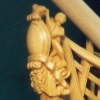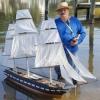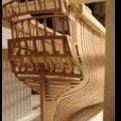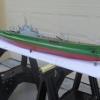-
Posts
2,213 -
Joined
-
Last visited
Reputation Activity
-
 EdT got a reaction from JerryTodd in Young America 1853 by EdT - FINISHED - extreme clipper
EdT got a reaction from JerryTodd in Young America 1853 by EdT - FINISHED - extreme clipper
I never use emoticons, Druxey, but I attempted it to show my comment on the likes was in jest - a wink and a smile. All sympathy is appreciated - humor helps as well.
Tom, I dug up a photo showing the octagonal mandrel. When using this to stretch an octagonal ring, the octagon should be formed on the mandrel before stretching. Except for the piece on the left, these are all hard maple. If I anticipated many more years of modeling, I would make these in brass, or perhaps just a harder wood, like box. Also, the tapers need to be very gradual. The diameter of the 12" long octagonal mandrel goes from about 3/32" to 3/8" at the large end. The large one on the right was used for mast rings.
-
 EdT got a reaction from tadheus in Young America 1853 by EdT - FINISHED - extreme clipper
EdT got a reaction from tadheus in Young America 1853 by EdT - FINISHED - extreme clipper
I never use emoticons, Druxey, but I attempted it to show my comment on the likes was in jest - a wink and a smile. All sympathy is appreciated - humor helps as well.
Tom, I dug up a photo showing the octagonal mandrel. When using this to stretch an octagonal ring, the octagon should be formed on the mandrel before stretching. Except for the piece on the left, these are all hard maple. If I anticipated many more years of modeling, I would make these in brass, or perhaps just a harder wood, like box. Also, the tapers need to be very gradual. The diameter of the 12" long octagonal mandrel goes from about 3/32" to 3/8" at the large end. The large one on the right was used for mast rings.
-
 EdT reacted to rwiederrich in Young America 1853 by EdT - FINISHED - extreme clipper
EdT reacted to rwiederrich in Young America 1853 by EdT - FINISHED - extreme clipper
Unfortunately the broken spar was almost inevitable....as the meat of the spar becomes less but the iron work remains the same.
In their weakened state, with holes drilled through for jackstay eyebolts and in frequency....these slender spars have little in the way of rigidity when forcefully applying copper banding. I know this feeling myself...regrettable.
If I took a picture every time I broke something or lost something in the hole that is the floor of my shop.....I would have no band width left for actual construction images.
Ed your masterfully crafted YA is nearing her completion and the thrill of watching her come together leaves a giddy feeling.
Wonderful.
Rob
-
 EdT reacted to druxey in Young America 1853 by EdT - FINISHED - extreme clipper
EdT reacted to druxey in Young America 1853 by EdT - FINISHED - extreme clipper
I think the 'likes' indicated sympathy, Ed. Mine certainly did.
-
 EdT reacted to Piet in Young America 1853 by EdT - FINISHED - extreme clipper
EdT reacted to Piet in Young America 1853 by EdT - FINISHED - extreme clipper
Hello Ed,
Caught up after a few months and just want you to know that I thoroughly enjoy watching your build and learning on the way.
I have been lurking since the start but refrain from making comments because I know zip about these ships. I just love to watch a jewel appear under your skillful hands.
Cheers,
-
 EdT reacted to usedtosail in Young America 1853 by EdT - FINISHED - extreme clipper
EdT reacted to usedtosail in Young America 1853 by EdT - FINISHED - extreme clipper
One more question if you don't mind Ed. When you put the round band over the octagonal center section of a yard, how do you get the band to fit snug to the faces of the octagon? Thanks.
-
 EdT reacted to wefalck in Young America 1853 by EdT - FINISHED - extreme clipper
EdT reacted to wefalck in Young America 1853 by EdT - FINISHED - extreme clipper
Sorry referring to a mishap, but the broken sky-sail yard made me think again of a question I wanted to ask for a while: what is the smallest diameter yard you think you can produce in this way.
I have been rather wary of breaking wooden yards and masts and started to make them from steel rod with turned-on bands - works well, but drilling for the eye-bolts is difficult. Brass drills more easily, of course, but is not really stiff enough. However, your successes make me re-think ...
-
 EdT reacted to Dowmer in Young America 1853 by EdT - FINISHED - extreme clipper
EdT reacted to Dowmer in Young America 1853 by EdT - FINISHED - extreme clipper
Ed,
Great descriptions of the process.
Question, (I apologize if you mentioned this earlier but with the large thread it would be impossible to find it)
For you soldering work of the copper or brass, what flux and solder do you use? I’m assuming you don’t use “Staybrite” solder. Is it some kind of paste so you can control the quantity and location with small parts? Soldering iron or mini torch? A bit of a tutorial would be appreciated.
Thanks in advance.
-
 EdT reacted to Mirabell61 in Young America 1853 by EdT - FINISHED - extreme clipper
EdT reacted to Mirabell61 in Young America 1853 by EdT - FINISHED - extreme clipper
filed surface....
Greg,
I can remember my days as an apprentance, when the master was teaching the young guys to file a flat surface to a steel chunk, which also had to be perpendicular to the sides.....
most of us had produced (common) a slight convex surface, whereby the master meant that a real good job would produce a slight koncave surface , because it was possible due to the files shape, wow !!!
Nils
-
 EdT got a reaction from BETAQDAVE in Young America 1853 by EdT - FINISHED - extreme clipper
EdT got a reaction from BETAQDAVE in Young America 1853 by EdT - FINISHED - extreme clipper
Thank you all for the likes and comments - appreciated as always.
Druxey, actually the monkey gaff may be used as a toothpick in a pinch - not that I would do that of course.
Micheal. drilling the holes in the spars is a good example of letting the process develop before locking practices into mass production. After experiencing the issues of clamping and centering a round tapered spar for drilling the evenly spaced, centered jackstay eyebolt holes, drilling them as a first step was a clear improvement still available for the remaining two dozen.
Kurt, thank you. We had a wonderful Thanksgiving even though we could not assemble the entire brood this year. We'll should be correcting that at Christmas. I have not thought about percentage complete - in fact I have some trouble remembering the year I started this - fall 2013 I believe. I will guess that the model is 95% complete and I am hoping to complete it early in the year.
Daniel, I will see if I can get an illustrative photo, but I can tell you that most - not all - of the lines that run through the fairleads in the top run down behind the shrouds and through a shroud fairlead, then belay on the side rail. I try to pass them through the futtock shrouds and through the shrouds above the futtocks in a straight line to their destination. For those going through a shroud fairlead this is usually to one side or the other of the line's fairlead shroud. I normally wet about an inch of the line with thin CA, then straighten and sharpen it with scissors to help thread it through from top to bottom.
Thanks again everyone.
Ed
-
 EdT got a reaction from BETAQDAVE in Young America 1853 by EdT - FINISHED - extreme clipper
EdT got a reaction from BETAQDAVE in Young America 1853 by EdT - FINISHED - extreme clipper
Young America - extreme clipper 1853
Part 312 – Spar Making Marathon
Not a lot new in this post. Mostly work that has been shown before. I normally work sequentially, completing an item through all the steps, then installing and rigging it. This helps uncover any problems with the design or methods and allows corrections to be made before errors are duplicated. With the spar making process pretty well in hand and quite a few left to make, I decided to work these together to save time. Forming the remaining upper yards – three for the main and five for the mizzen - is described in this post.
The blanks for all the spars had been cut and sized earlier – the so-called "first trims" – squares of the maximum spar diameter cut to length. After marking the centerlines and quarters, centerline holes for the jackstays and sheet sheaves were drilled as shown in the first picture for one of the larger yards.
After centering and determining the spacing for the jackstay stanchions the holes were drilled using the mill hand wheel to locate each .024" hole. Where yards had internal sheaves for sheets, these were also drilled to the required size.
After this drilling, each spar was shaped and finished before proceeding to the next. Some of these steps are described below. I believe all have been described in earlier posts. This next picture shows the first tapering steps on one of the spars, with the work held in a vise in this case.
The vise was used in this way for the first tapering on smaller spars, instead of the cam fixture shown below. Once two opposite faces were shaped to form the second trim, the larger tapered spars were mounted as shown below to form the tapers on the two remaining sides.
To adapt this fixture to smaller work, it was modified by substituting a fixed straight fence as shown in the next picture.
This eliminated flexing of the small spars between the cams. These spars are also small enough to deflect at the ends to the straight line of the fence. Final shaping, and most of the shaping on the smallest spars, was done using a sanding block with 220-grit paper as shown in the next picture.
This works well for light wood removal and also for maintaining fair curves along the spar. With the four sides tapered, the octagonal shape was first applied at the ends, around the square sections.
I made rounded transitions on the insides of these sections, but squared off on the outer side to receive the yard arm bands. The octagonal shape was then filed on each spar inside the square end sections. This process was illustrated in earlier posts.
In the next picture, the central octagonal area of one of the spars has been marked and the rounding has begun starting with file strokes that begin at the mark and remove the eight corners along the spar.
All the square yards are left octagonal at the center. Finally, the remaining corners are filed off to form the rounds.
A smaller grooved holder is shown above, but much of this final rounding is hand held. The corners are first removed using the file, then with a sanding stick. Throughout all the above work, calipers are used to check both diameters at the quarters and the rounded shape.
The last picture shows the set of finished spars – the last significant wood work on the model.
The top three spars in the picture are the main topgallant, royal, and skysail yards. The next five are the mizzen from the lower topsail up to the skysail. The very small spar at the bottom of the picture is the mizzen monkey gaff. All have been finished with one light coat of wipe-on poly to help keep them clean as the ironwork is added – the next work to be done.
Ed
-
 EdT got a reaction from BETAQDAVE in Young America 1853 by EdT - FINISHED - extreme clipper
EdT got a reaction from BETAQDAVE in Young America 1853 by EdT - FINISHED - extreme clipper
Lou, thank you for you comment. It has been some time since I have seen your presence on MSW - was it Cutty Sark posts?. My camera does indeed have a white balance function that I keep set to auto. The color correction issue in my shop is due to a variety of lighting types in different areas - florescent overall, incandescent or LED spot lighting, and sometimes sunlight. These differences effect the photos depending on the location of the shot. So, to avoid constant resetting of the camera, I use auto white balance, then post-correct. I also occasionally use other cameras as well as the iPhone and these produce different hues. I post-correct to make them more consistent and to bring them closer to my perception by eye - using auto color balance, lightness/contrast, and sometimes RGB adjust. I do this for each post when I crop and shrink the images. Monochrome photos for the books also require post-work - usually lightness and contrast.
I will try the white balance method you suggest.
Ed
-
 EdT got a reaction from Jeronimo in Young America 1853 by EdT - FINISHED - extreme clipper
EdT got a reaction from Jeronimo in Young America 1853 by EdT - FINISHED - extreme clipper
I never use emoticons, Druxey, but I attempted it to show my comment on the likes was in jest - a wink and a smile. All sympathy is appreciated - humor helps as well.
Tom, I dug up a photo showing the octagonal mandrel. When using this to stretch an octagonal ring, the octagon should be formed on the mandrel before stretching. Except for the piece on the left, these are all hard maple. If I anticipated many more years of modeling, I would make these in brass, or perhaps just a harder wood, like box. Also, the tapers need to be very gradual. The diameter of the 12" long octagonal mandrel goes from about 3/32" to 3/8" at the large end. The large one on the right was used for mast rings.
-
 EdT got a reaction from BETAQDAVE in Young America 1853 by EdT - FINISHED - extreme clipper
EdT got a reaction from BETAQDAVE in Young America 1853 by EdT - FINISHED - extreme clipper
Yes, an interesting problem, Druxey – and one that merits some consideration since it has noticeable effects on the model – some potentially negative, some perhaps helpful. I would be interested in hearing more about your hardening process, but I assume it is as described in Swan IV.
After making rope, I stretch and hold the line until it stabilizes at the stretched length – usually a 5 to 10% increase in length. I then dye it (aqueous) and hang it to dry, then pass it through a flame to remove fuzz. Lately I have been adding a "sizing" of diluted PVA to reduce later fuzzing – passing the line through the solution, re-drying it and again flaming it. I am still experimenting with this sizing step. I am doing this to combat fuzzing of cotton lines during rigging.
(Illogical paragraph suggesting rope increases in length due to moisture removed to avoid confusion. Rope actually shrinks when wet.)
Treating the rope to reduce moisture absorption should reduce the effects of moisture on length. I have soaked the larger stays with a solution of wax after installation, but do not know if this has helped. The waxed lines did sag. I also do not know what effect the glue treatment will have. Both these treatments should reduce the moisture effect - but to what degree?
-
 EdT got a reaction from BETAQDAVE in Young America 1853 by EdT - FINISHED - extreme clipper
EdT got a reaction from BETAQDAVE in Young America 1853 by EdT - FINISHED - extreme clipper
It is probably better to have taut lines relax when humidity drops rather than having taut lines tighten further when humidity rises. This could easily distort masts and spars. One solution would be to pre-dampen lines that are run during very dry conditions. I found that my lines that had gone slack with the drop in humidity tightened right up again when dampened. Of course, this applies mainly to long lines.
Ed
-
 EdT got a reaction from BETAQDAVE in Young America 1853 by EdT - FINISHED - extreme clipper
EdT got a reaction from BETAQDAVE in Young America 1853 by EdT - FINISHED - extreme clipper
Jan, I will try try to answer this by saying that various methods were used. Normally the tension would be applied at the lower end of the stay after fitting the collar over the masthead at the upper end - at least that is my interpretation. The lower end could be a thimble attached with a lashing that would allow for some adjustment, or the rope might pass through a bullseye or even an eyebolt if the rope was small enough. The doubled forestay was looped under the bowsprit and each leg seized to the other above on the opposite side. All these lower ends could then be hauled tight and secured with seizings. The final tension on the stay would be supplied by tightening the backstays and initially the shrouds- usually the backstays. These were fitted with deadeyes and lanyards for this purpose and were hauled up after securing the forward stays - I believe. This is the general approach I am following, using seizings or simulated wrapped splices at the top end collar. Hope this helps.
-
 EdT got a reaction from Piet in Young America 1853 by EdT - FINISHED - extreme clipper
EdT got a reaction from Piet in Young America 1853 by EdT - FINISHED - extreme clipper
Thank you Piet and Tom, and thanks to the 10 who have "liked" the picture of my broken yard 😉😊.
Tom, I have used three different methods to solve the problem of getting a round band to fit tightly over the octagon at the center of the yard. The first is just to push it over and flatten the sides when it is in place, but if very tight, the band may shave the neat corners off to some degree. Another method is to use small pliers to shape one end of the band then push it over and finish the shaping when it is in place. In both these methods the band may fit somewhat loosely, allowing it to move, but these central bands usually have top and bottom eyebolts that will keep the band in place. The best method is to use a tapered, octagonal mandrel - easily made from hardwood like the round one, using the methods for shaping spars. This is a good way to practice shaping regular octagons and once made will make the central banding problem much easier. I adopted this method late in the process - to my regret. I will look for a picture.
Ed
-
 EdT got a reaction from BETAQDAVE in Young America 1853 by EdT - FINISHED - extreme clipper
EdT got a reaction from BETAQDAVE in Young America 1853 by EdT - FINISHED - extreme clipper
Thank you, Greg and Micheal and others for the likes.
The catenary curve on models is easily disrupted by irregularities in the small rope as well as the light weight. However, I believe if the rope is fairly uniform and well stretched, then installed taut under humid conditions, the relaxation when it dehydrates will cause it to droop in a smooth curve - at least that is what I am seeing in the slack lines I mentioned. The smaller, lower yard bowlines are nicely curved as well. Some of the very small lines not so much.
Thanks again, Micheal for your comments on the small scale. It has its advantages and disadvantages. The latter are felt in the close up photos and while some of the flaws revealed in pictures like the one of the fore top may be correctable, some are just too small too fix - at least for me. The excess ends on the seizings and lashings being the most problematical.
Thanks for the comment on the photo, Greg - taken with my iPhone. Most of the the photos for the posts and the books were taken with a Nikon D3100 SLR with aperture priority - stopped down to around F22 to maximize depth of field - no question of handheld for these because of the slow shutter speed. The iPhone pics are very crisp at the focal point in closeup situations but the depth of field is very shallow - sometimes a good thing, but often not. The phone has the virtue of small size so it can be inserted into the model. I have been experimenting with it for photos like the one above and also for deck-level photos. Unfortunately these photos often reveal even more glitches with the work.
thanks again for the comments.
Ed
-
 EdT got a reaction from BETAQDAVE in Young America 1853 by EdT - FINISHED - extreme clipper
EdT got a reaction from BETAQDAVE in Young America 1853 by EdT - FINISHED - extreme clipper
Young America - extreme clipper 1853
Part 311 – Main Topgallant Mast
It has been an interesting week in the shop. Temperatures in our area dropped below freezing this week, with the usual drop in humidity, causing the long stays on the model to sag somewhat from their taut condition when installed during the warmer, more humid months. The sag on these is not too displeasing and actually mimics the sag in the photos of the ship. I measured this by magnifying the images and drawing straight CAD lines to compare. This could be corrected by hauling up on the backstay lanyards but for now I am not doing this.
The topic in this part is the main topgallant mast. This and its crosstrees were made earlier. Before erecting the mast, the iron band for the royal futtock shrouds needed to be installed. This is placed at the smallest mast diameter, just under the octagonal hounds that spread outward to support the crosstrees. For this reason a soldered band cannot be used. The first pictures show the way I made this band.
The copper strip was first crimped around the mast in a way that formed two tabs on the aft side. One of these was cut shorter than the other so the longer end could be bent and pressed over the first to form the flange-like tab shown in the next picture.
In the picture this has been drilled for the four futtock shroud eyebolts. It was then blackened and the eyebolts glued in with CA. The crosstrees were then fitted and the mast erected. The next picture shows the foot of the installed mast and the turning-in of the two tg shrouds on the starboard side.
The mast fid with its shackle may be seen in the picture. The forward, served shroud has its deadeye turned in with three seizings. The second shroud, to the left, is ready for its throat seizing. The deadeye is held in an alligator clamp for this. The next picture shows the tg mast with lanyards threaded on two of the shrouds and other lines hanging loose.
The loose ends of the shrouds and seizings will be trimmed off when the glue coating dries. The forward stay has been run, but the upper collar seizing remains untied at this stage. The lower end of the stay is shown in the next picture.
The stay is served at this end and passes through a bullseye strapped to the fore lower masthead. It is then seized to an eyebolt through the center crosstree. This picture also shows the fully loaded fairlead planks with just a few spare, unused holes. The next picture shows a closer view of the shrouds as the tg backstay is being prepared.
The next picture shows the deadeye and lanyard connection of the backstay to the channel.
The stay and shrouds are threaded but will not be hauled tight until their port side counterparts and the forward stay are rigged. The next picture shows the state of the model before rigging the port side lines.
The sag of the topmast and lower mast stays may be apparent in this picture. While it is not very pronounced and perhaps realistic, it is counter to the desire for a tight, rigid structure – I guess.
Interspersed with the above work, the dreary and eye-straining making and tying of ratlines continues. I estimate there are around 650 of these on the model.
Ed
-
 EdT got a reaction from BETAQDAVE in Young America 1853 by EdT - FINISHED - extreme clipper
EdT got a reaction from BETAQDAVE in Young America 1853 by EdT - FINISHED - extreme clipper
Thank you all for these comments and likes.
Wefalck, as you say, placing a bit of card behind the shrouds is most helpful and I have done that where other rigging permits - another good argument for getting the ratlines on early in the process. When I started on the ratlines, I gritted my teeth and decided to form lashing eyes at each end, recognizing that this would be a major effort - especially at this scale where ratlines are No. 80 cotton (~.007" diam.) thread. I described the method for this in Part 283. Other parts describing stages of the ratline work are also described in Parts 213,228, and 240. Some of the methods evolved as the work progressed but Part 283 describes the lashing of eyes most clearly. To my regret, I could not manage this on the fore topgallant shrouds shown in the last part because other rigging denied access for my finger behind the shrouds. I find this necessary to steady the ratline so the needle can be passed through it to form the eye. Virtually all the other ratlines have eyes at both ends. A lesson on sequencing the work.
Michael, thank you. Longridge has always been my hero. I believe he did go this far - at least he describes this level in both his books - the first on his Cutty Sark model built in the early 30's and the second on the Victory model that followed. I cannot recall ever seeing his Cutty Sark, but the book on that model would be an indispensable resource for building that oft-modeled ship - and it was of use to me in designing the Young America rigging. Harold Underhill, a major source for me, seems to have been a major contributor to The Longridge clipper book. He did the drawings and perhaps the diagrams in the text. There is great similarity to his book - and equal level of detail.
All I can say about keeping track of all these lines and avoiding a complete tangle is - one at a time wherever possible, and diligent reliance on the (indispensable) rigging list - and oh yes, frequent breaks from the work.
Thanks again, everyone.
Ed
-
 EdT got a reaction from Piet in Young America 1853 by EdT - FINISHED - extreme clipper
EdT got a reaction from Piet in Young America 1853 by EdT - FINISHED - extreme clipper
I never use emoticons, Druxey, but I attempted it to show my comment on the likes was in jest - a wink and a smile. All sympathy is appreciated - humor helps as well.
Tom, I dug up a photo showing the octagonal mandrel. When using this to stretch an octagonal ring, the octagon should be formed on the mandrel before stretching. Except for the piece on the left, these are all hard maple. If I anticipated many more years of modeling, I would make these in brass, or perhaps just a harder wood, like box. Also, the tapers need to be very gradual. The diameter of the 12" long octagonal mandrel goes from about 3/32" to 3/8" at the large end. The large one on the right was used for mast rings.
-
 EdT got a reaction from BETAQDAVE in Young America 1853 by EdT - FINISHED - extreme clipper
EdT got a reaction from BETAQDAVE in Young America 1853 by EdT - FINISHED - extreme clipper
Young America - extreme clipper 1853
Part 310 – Some Loose Ends
In moving the main rigging installation forward, some finishing-up work inevitably got bypassed to be done later. Some of this was for access reasons, some to escape prolonged tedious tasks – for example, the seemingly endless "rattling down." Sometimes this multiplies the work, as in the first picture, where topgallant ratlines are being lashed after surrounding lines were installed.
This should have been done earlier, right after the tg crosstrees were installed. In the picture one of the ratline eyes is being lashed to the forward shroud. Two pairs of tweezers are being used. The blur in the picture is due to shaky hands. Use of a paper shield like the one in the next picture, helps avoid lashing down other rigging and helps visualize the work.
On these tg shrouds, where the work is obstructed, the second ends were clove-hitched due the difficulty of forming lashed eyes that were used on the lower and topmast ratlines. In addition to the upper ratlines, those on the lanyards and the futtock shrouds below must also being added. Fortunately there were no ratlines on the royal shrouds.
The next few pictures show the addition of the jib sheets on the forecastle. Each of the four jibs has a sheet on either side. Each sheet reeves through a double pendant middle and seized to the sail's clew cringle. The standing ends of these sheets are shackled to eyebolts on the rail. After they pass through bullseyes in the pendants they are belayed on cleats on the forecastle breast rail - with the sheet on the weather side taking the strain of the sail and the lee side slack. Lacking sails, the eight sheets are simply coiled on the forecastle as shown in the first picture.
Coils for the jib downhaulers were also added to the forecastle rail to the right. These are large coils because the long downhaulers are fully hauled in with no sails. The next picture shows the "off-site" fabrication of the sheet coils.
The lines were first spliced to eyebolt shackle assemblies, then wrapped around the plastic rod, then wetted with diluted glue and slipped off to dry. As with most of the rope coils on the model, the lengths approximate requirements of the line. The next picture shows the coils glued to the deck on the starboard side.
The two on the right, for the staysail and the inner jib, are 3 1/2" and 3" rope respectively. Those on the left, for the outer and flying jibs, are 2 ½" rope.
The next picture shows rope coils for the foremast rigging on the port pin rail.
Altogether there are about 60 coils associated with the foremast running rigging – on the port and starboard rails and the fife rails – excluding those for the yard braces and other deferred lines that will be added later. This picture also illustrates the role of the shroud fairleads in organizing the lines. I'm sure these also assisted in line identification.
The next picture shows most of the coils on the mizzen spider band, those associated with the rigged lower yards and the spanker.
Finally, after completing the belaying between the skid beams, the cutter was retrieved from storage and lashed down as shown below.
The other cutter will be hung from the quarter davits on the starboard side - later. I have yet to decide where to place the two lower studdingsail booms lying on the cabin roof in this picture. Also, lanyards on the last three backstays on each side, like the fore course sheets and tacks at the far right of the photo, have yet to be secured.
Ed
-
 EdT got a reaction from BETAQDAVE in Young America 1853 by EdT - FINISHED - extreme clipper
EdT got a reaction from BETAQDAVE in Young America 1853 by EdT - FINISHED - extreme clipper
Thanks, again, everyone.
Mark, its good to see you back on deck. Your comments are always well appreciated and the posts on your log always add items and methods of interest.
Pat, the complexity of lines on a ship like this - with 18 square yards - can be a bit daunting and trying to include a maximum number on the model may seem insane. If you view the ship as a complex machine as well as a thing of beauty - as I do - that is perhaps a reason to go to those lengths. Describing this for others is a challenge. So far, the method and information I have settled on for that seems to be working and my use of it for construction will let me hone it for use by others. I have started to bring this together in initial drafts, but there is still much to do with that - and on the model.
Ed
-
 EdT got a reaction from DORIS in Young America 1853 by EdT - FINISHED - extreme clipper
EdT got a reaction from DORIS in Young America 1853 by EdT - FINISHED - extreme clipper
I never use emoticons, Druxey, but I attempted it to show my comment on the likes was in jest - a wink and a smile. All sympathy is appreciated - humor helps as well.
Tom, I dug up a photo showing the octagonal mandrel. When using this to stretch an octagonal ring, the octagon should be formed on the mandrel before stretching. Except for the piece on the left, these are all hard maple. If I anticipated many more years of modeling, I would make these in brass, or perhaps just a harder wood, like box. Also, the tapers need to be very gradual. The diameter of the 12" long octagonal mandrel goes from about 3/32" to 3/8" at the large end. The large one on the right was used for mast rings.
-
 EdT got a reaction from Bob Legge in Young America 1853 by EdT - FINISHED - extreme clipper
EdT got a reaction from Bob Legge in Young America 1853 by EdT - FINISHED - extreme clipper
I never use emoticons, Druxey, but I attempted it to show my comment on the likes was in jest - a wink and a smile. All sympathy is appreciated - humor helps as well.
Tom, I dug up a photo showing the octagonal mandrel. When using this to stretch an octagonal ring, the octagon should be formed on the mandrel before stretching. Except for the piece on the left, these are all hard maple. If I anticipated many more years of modeling, I would make these in brass, or perhaps just a harder wood, like box. Also, the tapers need to be very gradual. The diameter of the 12" long octagonal mandrel goes from about 3/32" to 3/8" at the large end. The large one on the right was used for mast rings.








